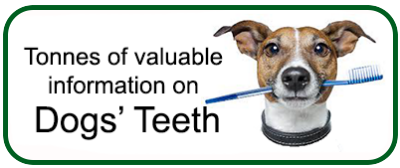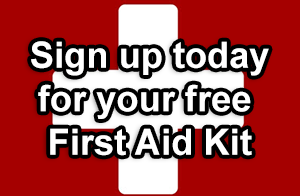Answers to frequently asked questions about dental care in dogs
First menu
Why should I brush my dog's teeth? | Do dogs wear braces? | Can toys and /or chew-treats play a part in protecting my dog's teeth? | How common is dental disease in dogs? | Is dental disease painful for dogs? | Can dental health affect my dog's behaviour? | How much does a dental cleaning procedure cost? | Should I be feeding my dog a special diet to protect its teeth? | What type of tests are done to diagnose dental disease? | At what age should I start worrying about dental problems with my dog?
Why should I brush my dog's teeth?
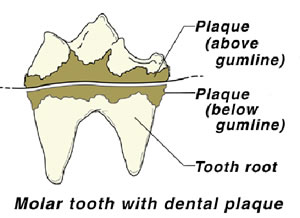
Removing Plaque from your dog's teeth on a daily basis is the key to maintaining a proper oral hygiene program for your pet. Unless your dog's teeth are Brushed daily, plaque will build up at the gum line. If left untreated plaque progresses to form Calculus, which irritates the gums and infection takes over. Eventually teeth begin to loosen and infection from the gumline can go on to spread to your pet's major organs - brain, liver, kidneys, heart and lungs.
Do dogs wear braces?
If needed, yes! Actually braces for dogs are not all that common but poorly aligned teeth are. The main goal of veterinary orthodontic therapy is to provide functional and comfortable occlusions (bites) for their patients. There are many causes for dogs to have mal-aligned teeth - some of these include:
- Retained baby teeth.
- Genetic predisposition
- Tug-of-war play - this point is agreed by breeders and disputed by Dog Othodontists!
- Poor nutrition.
- Tooth or jaw trauma.
Can toys and /or chew-treats play a part in protecting my dog's teeth?
You need to be discerning when selecting toys and chew-treats for your dog. Chewing on toys that are harder than the enamel on his teeth can and does lead to dogs having dental fractures. This is particular relevant to any products made of animal hooves, which frequently cause fractures of upper premolars.
And lastly, to be on the safe side of this subject, don't play "tug-of-war" games with young dogs.
Most breeders are of the opinion that prolonged tug-of-war games can cause growing teeth to move out of alignment and disrupt dogs' natural bites.
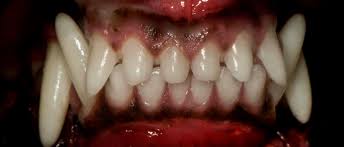
This is often disputed by dog orthodontists however, who say genetics is the only reason dogs teeth erupt out of alignment.
How common is dental disease in dogs?
Dental disease is one of the most common and serious ailments suffered by dogs! Eighty-five percent of all adult dogs have some degree of Periodontal Disease. The severity and incidence of dental disease increases as pets age. In fact, the vast majority of dogs 3 years of age or older have dental disease and are in need of professional dental care.
Is dental disease painful for dogs?
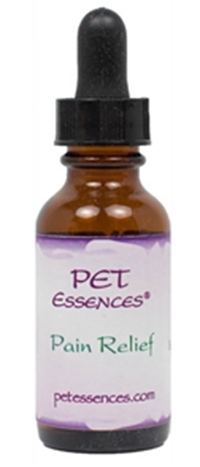
Yes, dental disease is very painful for dogs. There are many studies in place which show dogs experience pain just like humans, but intentionally hide their pain from us. It is called Mother Nature at work, because in the wild, instinct dictates to animals to hide their pain to protect themselves from predators.
This makes our job of helping our dogs that much harder and therefore we should always be on the look out for subtle signs of pain:
Protecting our pets from the agony of decaying and infected teeth and gums is one of the most kindest and important things we can do to keep our dogs happy, healthy, comfortable and above all pain free.
Can dental health affect my dog's behaviour?
My word yes! Many dog owners report significant improvements in their dog's behaviour after they have been treated for dental disease, such as, more playfulness and in particular reduced crankiness - no doubt the result of the relief of long standing chronic pain.
How much does a dental cleaning procedure cost?
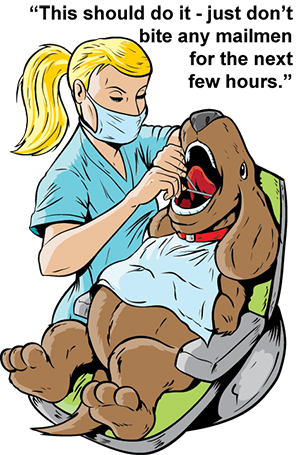
It's impossible to quote over the Internet how much a cleaning procedure will cost. It depends on the condition of your dog's teeth and gums. The fee range is based on:
- The preoperative tests done
- An anesthesia fee
- How many procedures are required
- Medications & intravenous fluids given
- Hospitalisation time required for recovery
Each dog's needs are different. Many vets offer free oral examination appointments and estimates, so don't delay, call your vet for an appointment today.
Should I be feeding my dog a special diet to protect its teeth?
Yes there are, I find K9 Natural frozen raw nibblets which come in beef, chicken and lamb varieties and K9 Natural freeze dried dog toppers which come in beef, lamb and lamb tripe varieties, are a natural fit for Molly and Rosie my two little darlings.
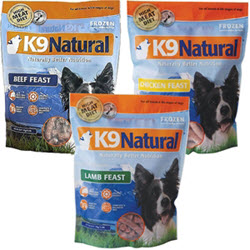
If you feed your dog canned or dried food, you must brush his or her teeth daily. We offer a huge range of treats, chews, biscuits and bones in our Dog Dental Care Products page.
What type of tests are done to diagnose dental disease?
Vets can tell simply by looking if Periodontal Disease is present. Vets use x-rays to evaluate and determine if teeth can be saved or should be extracted. Most pet owners go for extractions because of the cost of restoration. However people who need their dog as a working dog can claim restoration as tax deductable.
At what age should I start worrying about dental problems with my dog?
As soon as you adopt your puppy is the correct time to start worrying about his dental care and to introduce a daily brushing routine. Although their baby teeth are replaced by permanent teeth it is important for dogs to accept having their teeth cleaned as part of their daily grooming routine. In the case of dogs and brushing their teeth it is far easier to teach young dogs new tricks than old dogs.
Second menu
Photos of the 4 stages of periodontial disease |
What can be done for my dog if it has periodontal disease? |
What are contributing factors for periodontal disease? |
What are some of the signs and symptoms of periodontal disease in dogs? |
What can I do to reduce the risk of my dog getting periodontal disease |
Is it ever too late for dental care for my Dog? |
What is an Naso Oral Fistula |
What causes dogs teeth to chip or fracture?
What should I do if my dog breaks or shatters a tooth?
Photos of the 4 stages of periodontial disease

What can be done for my dog if it has periodontal disease?
It depends very much at what stage the periodontal disease has progressed to. Normally periodontal disease is irreversable and your only alternative is to ask your vet to remove all the decaying roots and teeth and generally clean up your dog's mouth, followed by a course of anitibiotics.
What are contributing factors for periodontal disease?
- Breed - periodontal disease is more common in smaller breeds of dogs.
- Age - periodontal disease is more common as pets grow older.
- Poor oral hygiene at home - owners who fail to brush their dogs teeth, and ignore the onset of signs and symptoms of periodontal disease along with loss of teeth and other health problems.
- Diet - owners who feed their dogs refined carbohydrates and soft sticky foods.
What are some of the signs and symptoms of periodontal disease in dogs?
Common warning signs and symptoms are:
- Bad or foul breath.
- Dogs pawing at their face or mouth - indicating severe pain.
- Depression and lethargy.
- A change in chewing or eating habits.
- Discoloured teeth indicating the presence of Plaque or Calculus.
What can I do to reduce the risk of my dog getting periodontal disease
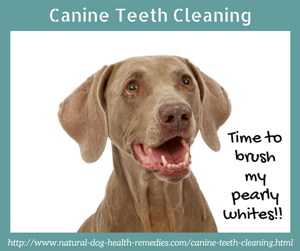
You can reduce the risk of oral disease in your dog by treating your dog's mouth in the same way as you treat your own mouth. The first step is to book your dog in to your family vet for an oral health check and heed all the advice given. Thereafter you should:
- Brush Your Dogs Teeth daily preferably after he or she has eaten.
- Diet - try introducing your dog to a raw diet to include soft raw bones e.g.chicken necks or beef brisket bones.
- Have your dog's teeth checked at least once or twice a year by your vet.
Is it ever too late for dental care for my Dog?
No, its never too late for you to save your pet from pain and suffering. As we have discussed many times throughout this site, with proper oral care, dental disease is preventable; and for the poor dogs who have irreversible periodontal disease, the very least you can do is to be kind enough to put them out of their pain and misery by having their decaying teeth extracted.
Occasionally pet owners think their dog is too old or too sick for anesthesia and dentistry, but most times the benefits of relieving the pain and treating the infections of oral disease far outweigh the risks of the procedure. Owners are very often pleasantly surprised by how young and sprightly their older dog can behave after treatment for Periodontal Disease.
What is an Naso Oral Fistula
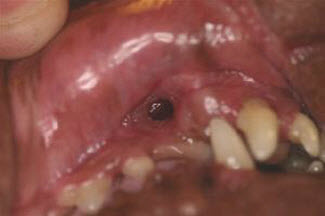
An oral nasal fistula is one of the symptoms of advanced periodontal disease, where decay and infection progress to the point of involving the periodontal attachments and bone of upper canine and first premolar teeth and finally reach the nasal cavity.
Oral nasal fistulae can occur in the incisor region but with much less frequency. The reason being that the roots canines and first premolars run up and along side the nasal cavity, which is separated from them by paper thin sheets of bone. Thus making them most suseptable teeth to the ravages of advanced dental disease.
The result is inflammation and infection of the nasal cavity and respiratory tract, caused by food and oral fluids perculating into and out of the respiratory tract.
If you suspect your dog may be suffering from a naso oral fistula, head for your vet asap, delay in treatment could result in bacteria and infection progressing to his major organs and the outcome for Fido could well sbe fatal. For more detailed information and treatment options please go to the website of the Iowa State University College of Veterinary Medicine
Oral naso fistulae are most common in small breeds such as Daschunds, Yorkshire Terriers, Maltese, Poodles.
What causes dogs teeth to chip or fracture?
Chipped or fractured teeth happen when dogs are chewing something which is harder than the enamel on their own teeth, e.g. toys or bones or some other object they decide to chew on. Since dogs like to hide their pain, owners may not pick up on their pets' discomfort immediately. Signs which indicate dogs are experiencing extreme mouth pain include:
- Obvious signs of chipped or fractured teeth.
- Excessive drooling.
- Avoidance of hard foods and showing a preference for soft foods.
- Signs of pain, e.g. excessive and constant pawing at their face.
- Behavioral changes, e.g. crankiness, lethargy.
- Loss of interest in chewing toys and bones.
If you pick up on any of these signs and or symptoms, please seek veterinary advice immediately.
What should I do if my dog breaks or shatters a tooth?
If your dog breaks its tooth, take it to your vet immediately - time is of essence, please don't delay because your dog will be in excruciating pain. There are two treatment options:
- Root canal therapy with a crown.
- Extraction.
You can not and must not leave your dog with an untreated broken tooth. The pain of a broken tooth is unbearable, this is because the pulp canal which houses the nerve and blood supply is exposed. Apart from the horrendous pain factor, if left untreated, bacterial infection can and will enter the pulp canal and travel to and infect other major organs.
This article and information forms part of the Carole's Doggie World Library and is presented for informational purposes only.The information is not intended to be a substitute for visits to your local vet. Instead, the content offers the reader information researched and written by Carole Curtis for www.carolesdoggieworld.com

